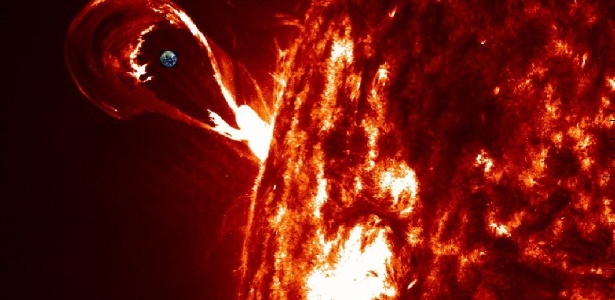It’s only a matter of time before Earth is hit again by a solar storm. In 1859, on the 1st and 2nd of the month, the plan already lived this: it was the Carrington Event. At that time, telegraphs around the world stopped working. However, nowadays such a storm could cause damage to electrical and communication systems around the world.
To protect the planet from such issues, it is necessary to continue to encourage research into the effects of these storms, such as installing devices that can ensure the safety of vulnerable equipment (transformers), and developing strategies to adjust grid loads when solar storms are about to occur.
Understanding what the Carrington event was
The Carrington Event was the largest record of a solar (or geomagnetic) storm, but it is not an isolated case. It is worth explaining that these storms occur when a large bubble of superheated gas, known as plasma, is ejected from the sun’s surface and hits Earth. The bubble is called a coronal mass ejection.
Plasma consists of a cloud of protons and electrons, electrically charged particles, which, upon reaching Earth, interact with the magnetic field that surrounds the planet. This interaction causes the magnetic field to deform and weaken, increasing the chances of natural phenomena happening.
What are solar (or geomagnetic) storms?
Since the beginning of the 19th century, it is possible to find records of these types of phenomena. Scientific data from Antarctic ice cores still show evidence of an even more massive geomagnetic storm in 774 AD, known as the Miyake Event.
The explosion in question produced the largest and fastest increase in carbon-14. Generally speaking, geomagnetic storms are capable of unleashing large amounts of cosmic rays into the atmosphere, which in turn produce carbon-14, a radioactive isotope of carbon.
There was another geomagnetic storm; this time, 60% smaller than the Miyake Event in 993 AD. Ice samples have shown that large-scale geomagnetic storms with similar intensities as the Miyake and Carrington events occur every 500 years on average.
The National Oceanic and Atmospheric Administration works with a Geomagnetic Storm scale to measure the strength of these solar flares. The so-called “G scale” has a rating of 1 to 5, with G1 being minor and G5 extreme. The Carrington Event would have been classified as G5.
Consequences of the storm
Today, a solar storm like the Carrington Event could be catastrophic, affecting all electrical systems. This phenomenon generates induced currents, which flow through the electrical network.
One hundred amps is equivalent to the electrical service supplied to many homes. Currents of this magnitude can cause internal component damage and large-scale power outages.
A geomagnetic storm three times smaller than the Carrington Event occurred in Quebec, Canada, in March 1989. During the storm, the high magnetically induced currents damaged a transformer in New Jersey, United States, and tripped grid circuit breakers, leaving five million people without power for nine hours.
In addition to electrical failures, communications could be disrupted on a worldwide scale, with Internet service providers outages, TV, navigation (GPS) and telephony service problems.
In addition, increased solar activity causes the atmosphere to expand, changing the density of the atmosphere where the satellites are orbiting. The higher density atmosphere creates drag on a satellite, which slows it down, and if not maneuvered into a higher orbit, it can be destroyed upon returning to Earth.
*With information from The Conversation
–

:quality(80)/cdn-kiosk-api.telegraaf.nl/89e54d44-a95d-11ec-a474-0217670beecd.jpg)
